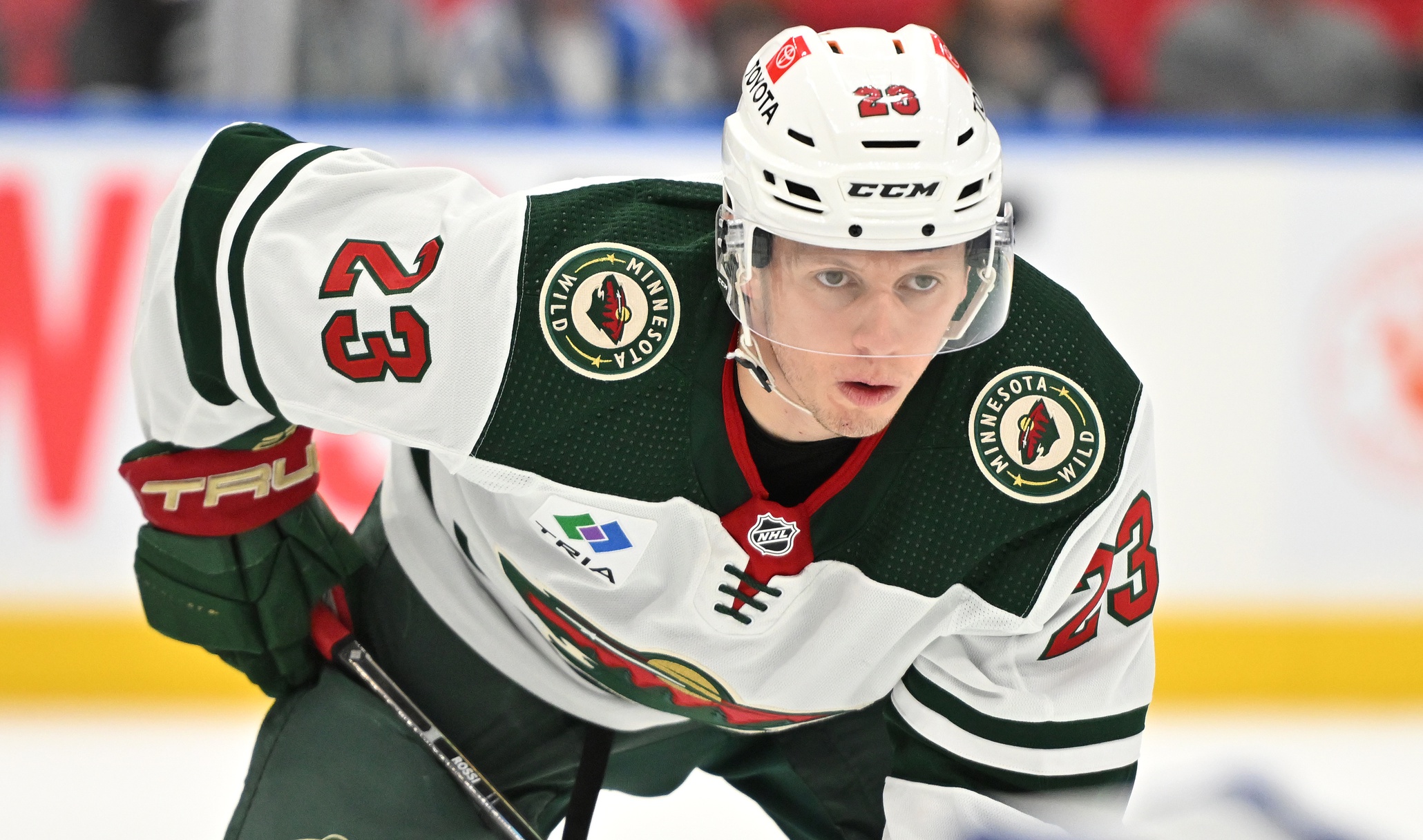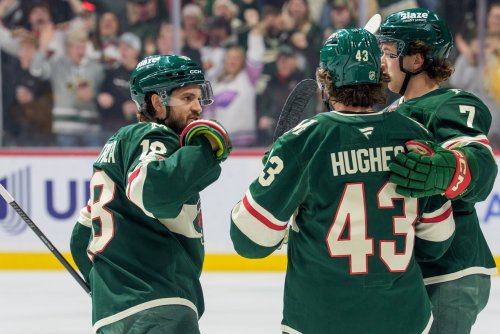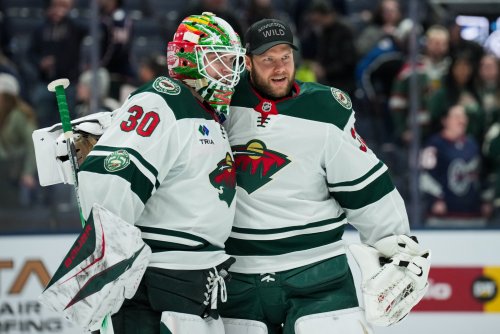
There was a lot of attention on Marco Rossi before the Minnesota Wild drafted him. Rossi had otherwordly OHL production, but at only 5-foot-9, he was an anomaly. Most draftniks felt that either his skill would carry him to superstardom or his size would doom him as a draft bust. There is rarely nuance around draft time.
That narrative grew louder last season when Rossi followed up his stellar AHL debut by performing poorly in 16 NHL games. He couldn’t score, and he didn’t drive play. Worst of all, Rossi looked passive. He looked too small.
Eventually, the Wild sent Rossi down, upsetting a portion of the fanbase. Whether you were a Rossi truther or a doubter, it’s never good for a franchise when their ninth overall draft selection performs poorly in his first real shot in the NHL. As Rossi’s would-be breakout season wound down without another callup, comment sections started to murmur the “B”-word.
As discouraging as Rossi was last season, he may be tracking on Joel Eriksson Ek’s timeline. Eriksson Ek is currently the best center the team has developed in the past decade. It’s easy to forget his early-career struggles, since Minnesota only had Eriksson Ek play nine games in Iowa. However, it becomes more evident if you sync their timelines by draft year.
The Wild drafted Eriksson Ek 20th overall in 2015; they took Rossi ninth overall five years later. Rossi was a more coveted prospect, but they shared the weighty expectations of being a first-round center. Mikael Granlund and Luke Kunin were the only other centers Minnesota drafted in the first-round centers from 2007 to 2022. Fans and the organizations hyped all four players from draft day onward.
Eriksson Ek and Rossi immediately faced adversity the year after the Wild drafted them. Rossi lost his entire season due to heart complications with COVID. Eriksson Ek was able to play in 2015-16, but he failed to improve his production. While his SHL numbers were slightly better, that doesn’t account for the monster workload he added on in the J20 SuperElit league in 2014-15.

But Eriksson Ek and Rossi improved by leaps and bounds in Year 2. Eriksson Ek began the regular season with Minnesota in 2016-17, posting five points in his first four games. But the Wild returned him to the SHL to preserve the first year of his entry-year contract (ELC) and because they had no room for him. Upon his delayed return to the SHL, he matched his point totals from the previous season in significantly fewer games.

Upon returning from illness, Marco Rossi posted a season analytically identical to Eriksson Ek’s by NHL-equivalent points (NHLe). HockeyProspecting.com’s metric adjusts point totals in minor leagues to a comparable number of NHL points. Essentially, the harder the league, the more credit a player gets for scoring. It also gives more weight to goals and primary assists than raw point totals to make it more predictive of future scoring at higher levels. Despite spending months away from the game, Rossi’s offense was on track with Eriksson Ek’s.
That may seem discouraging, given that Rossi is projected as a scorer, while Eriksson Ek’s superpower is his 200-foot game. However, it’s important to note that Eriksson Ek’s scouting reports initially focused on his scoring ability rather than his defensive game. Eriksson Ek’s shot is the first attribute his NHL.com scouting report mentions. He developed his two-way hockey abilities later in his career.
Many players learn defense later in their careers. That’s especially true when they are gifted scorers at lower levels. If Eriksson Ek focused on scoring in the SHL, NHLe seems like a roughly fair measure to compare these two players -- especially after accounting for the season he lost to COVID. Therefore, the two players were roughly on the same track through two years.
But the comparison becomes most interesting in Year 3. Both players were so good in Year 2 that they essentially forced the coaching staff to give them a look with the NHL club. Rossi flopped in Year 3 last season. However, Eriksson Ek played in 75 NHL games in his third year. At first glance, he seems to be pulling ahead of Rossi.
But digging deeper, it’s apparent that Eriksson Ek’s 2017-18 campaign was not a breakout year, either. He barely scored (6 goals and 10 assists, ranked 441st in points among NHL players). Worse, Eriksson Ek’s shooting was inefficient, scoring only five 5-on-5 goals on his 8.9 expected goals (xG) per MoneyPuck.com. His xG ranked ninth among Wild forwards.
Defensively, Eriksson Ek was no better than league-average in his bottom-six role, posting a plus-2 plus/minus. Analytically, MoneyPuck pegs the Wild as having 52.2% of the scoring chance quality in their favor with Eriksson Ek on the ice, based on shot volume and shot location. Bruce Boudreau shuffled Eriksson Ek all around the lineup but played most of his minutes with Marcus Foligno, Daniel Winnik, and Chris Stewart. Stewart and Winnik were not effective hockey players, and Foligno was not yet the defensive stalwart he is now. Eriksson Ek was a stereotypical fourth-liner.
Rossi didn’t earn 75 NHL games in his third season like Eriksson Ek, but he had a stronger year in almost every other area of prospect development. Rossi put on another offensive clinic in the AHL, out-pacing his scoring from the year before. He also expanded his role to include penalty killing, leadership duties, and playing more minutes. While it was disappointing to see the pro club demote Rossi, he still made progress. For Eriksson Ek, the only progress was that he played in the NHL. He rarely scored, and he barely drove play. Sound familiar?

If Marco Rossi follows that trajectory, last year’s demotion will be as faint a memory as Eriksson Ek’s snakebitten early years. Perhaps Rossi will develop into a high-end checking center, much like Eriksson Ek. Few expected his Swedish counterpart to take that path, simply because they couldn’t look past his flashy abilities in the minor leagues -- even though the lower body strength and hockey IQ were right there to be seen.
It’s more likely that Rossi will continue to play with shutdown enforcer Foligno on his wing. Between Rossi’s offensive talents and Foligno’s defense, it seems like a situation where any player could find chemistry. Rossi will have either an offensive support or another defensive specialist to feed him pucks. Meanwhile, Evason can shelter him from his opponents’ best checkers so that Rossi can adjust to the NHL, just as Eriksson Ek gradually gained confidence on Minnesota’s third line in his fourth season.
For Rossi, this year doesn’t have to be about breaking out as the dominant top-line center that the Wild have pined after for so long. Instead, it’s about Rossi defining his identity. He needs to discover his superpower, just like Eriksson Ek uncovered his dominant two-way game five years ago. That’s a bit of a nuanced take, but don’t let that discourage you. Within that nuance, there’s room for Rossi to find out he’s every bit as special as anybody could have hoped.
Points and Games Played statistics courtesy of eliteprospects.com.
Think you could write a story like this? Hockey Wilderness wants you to develop your voice, find an audience, and we'll pay you to do it. Just fill out this form.
-
 1
1







Recommended Comments
Join the conversation
You can post now and register later. If you have an account, sign in now to post with your account.
Note: Your post will require moderator approval before it will be visible.